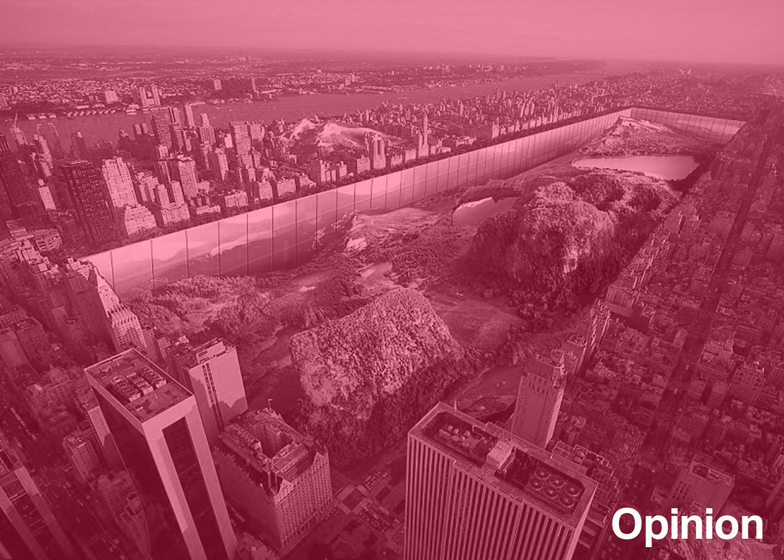Opinion: a proposal to surround New York's Central Park with a giant "sidescraper" epitomises architects' disregard for designed landscapes, says president of The Cultural Landscape Foundation, Charles A Birnbaum.
What does it say about the architecture profession that a design concept that would destroy New York's Central Park as we know it has gotten publicity of Donald Trump proportions?
While the destruction of sections of the ancient Syrian city of Palmyra, a UNESCO World Heritage Site, has engendered international opprobrium, the winning design in eVolo Magazine's 2016 Skyscraper Competition, which proposes to completely eradicate a potential UNESCO World Heritage Site, is called "brilliant".
New York Horizon, the winning design by the architects Yitan Sun and Jianshi Wu, proposes to excavate Central Park down to bedrock and build what has been termed a "sidescraper" along the entire perimeter. According to the designers' statement, "the ambition is to reverse the traditional relationship between landscape and architecture."
Designed by Frederick Law Olmsted Senior, (the "Founding Father" of landscape architecture) and Calvert Vaux, Central Park is arguably the most important work of art created in America in the 19th century. Yet, as we see constantly, designed landscapes are often viewed as merely incomplete or empty voids awaiting something to be placed within them, or, in this case, to be taken away.
We all know that competitions of this sort are designed to elicit over-the-top, outré, and avant-garde proposals. This one, however, isn't just harmlessly provocative click bait. It perpetuates a broken value system in which architecture is seen as the great saviour, while landscape architecture is treated as "parsley around the roast," as the great Modernist landscape architect Thomas Church once observed.
The designers' statement about their brainchild includes choice observations that highlight this disconcerting mindset: "This system breaks the traditional perception of large-scale skyscrapers without taking valuable ground area of Manhattan." Ergo, Central Park is not valuable ground, and the proposed alternative – dubbed "Central Pit" by a wry observer on Curbed New York – is seen in every way as equivalent. Here's another one: "This [design] creates a new urban condition, where landscape can serve as an inherent part of the city." What does that even mean? Our foundation's Facebook post about the Skyscraper Competition received some two dozen comments, among them: "This is the winner of the competition to prove how architects may further sequester themselves from humanity."
These theoretical flights of fancy have real-world implications, and are based on omnipresent and inherent biases that lead to actual harm. For example, the Obama Presidential Library will likely be built in Washington Park, one of two Olmsted-and-Vaux-designed parks in Chicago, which ranks among the designers' finest works. The proposal is to take approximately 23 acres of parkland for the complex. Mayor Rahm Emanuel has assured us, however, that we shouldn't worry, because his "park positive" approach means that any parkland lost to the library would be made up elsewhere in the city. Assuming that selective amputation were acceptable, this still fails because the "park positive" approach only replaces parkland lost to the building – approximately three acres – and not the entire campus. Moreover, there's ample building space elsewhere in the city and even across the street from the park.
We saw something similar in 2014, when the Frick Collection proposed an expansion that would have destroyed a rare Russell Page-designed garden. Fortunately, once the significance of the garden and its designer became clear, the museum shelved its plans (they have recently restarted the expansion process, but have vowed to keep the Page garden). Of the former Frick proposal, New York Times architecture critic Michael Kimmelman wrote, "Great public places and works of landscape architecture deserve to be treated like great buildings."
Despite that progress, the eVolo competition has clearly reaffirmed the continuing disparity in the values assigned to architecture and landscape architecture. As landscape architect Gina Ford noted on our Facebook page: "Reading a highly designed, uber-successful and culturally significant landscape as nothing more than negative space (or worse yet, soil to be relocated) is not 'reversing the traditional relationship between landscape and architecture'... It's actually like an intensified version of the worst parts of that traditional relationship. Unfortunate is an understatement."
Charles A Birnbaum is president and CEO of The Cultural Landscape Foundation, which was established in 1998. He is trained as a landscape architect, was in private practice in New York for 11 years, and spent 15 years with the National Park Service authoring national guidelines for the treatment of landscapes. He created The Cultural Landscape Foundation while serving as a Loeb Fellow at Harvard University and writes and lectures extensively.

